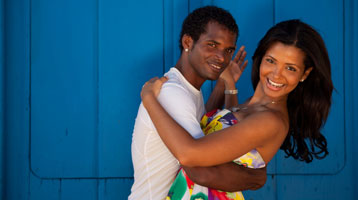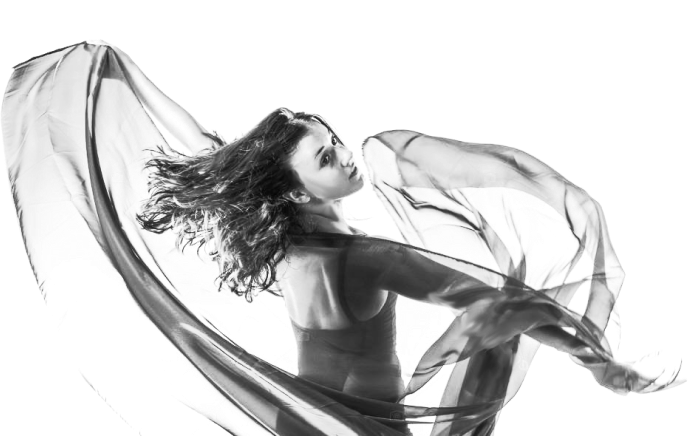
Latin Dance
Bachata
The Bachata is a playful Latin dance that is typically danced at Salsa and Merengue dance clubs. This style is danced with soft hip motions, turns and side-to-side footwork. The music of Bachata is very recognizable for its predominant use of the electric guitar combined with Caribbean and Latin musical influences.
History of the Bachata Dance
Bachata dancing holds a fascinating history with its beginnings rooted in the Dominican Republic. The word “Bachata” means “party” or “social gathering” and was originally used to describe the impromptu house parties of Santo Domingo. It was associated with carrying out festivities over the terraces, gardens, and streets of the nations’ capital. It is believed by some that those really wanting to learn how to do Bachata dance should travel to its birthplace, the Dominican Republic, to gain a genuine understanding of the movement, feeling, and way of life that was intertwined with this nation’s dance.
While parties made their mark in Santo Domingo, Bachata music developed all over the countryside and rural neighborhoods of the Dominican Republic. It evolved out of influences arriving from the nations’ neighboring countries Cuba and Puerto Rico, as well as other Latin music hubs. Bachata music mixed the two Cuban music styles, Son and Bolero, which were bought to the Dominican Republic by wandering Cuban musicians known as Travedores. These wandering musicians played melodies romantic in nature, in 4/4 timing, and oozing with poetic lyrics. Travedores played the guitar, and brought influence from Mexico’s rancheros and corridos in additional to their native Cuban styles. Bachata musicians drew upon Cuban influences, Puerto Rican plena and jibaro music, Colombian-Ecuadorian vals campesion and pasillow, as well as the Dominicans’ very own merengue, which was originally guitar based. Because of the often melancholy lyrics of lost love and heartbreak, Bachata music became known as “música de amargue”, meaning “music of bitterness”.
While Bachata dancing, parties, and music were very popular among the common people of the Dominican Republic, anything associated with Bachata was looked down upon by upper classes. The elite would never hold a party called a Bachata. They considered the dance to be vulgar and the music to be low quality. Bachata was repressed by Rafael Trujillo’s dictator regime and people looking for societal acceptance did not publicly play the music associated with brothels and barrios. While Bachata music began in the early decades of the 20th century, it didn’t really emerge until Trujillo’s regime came to an end in the 1960s. The first Bachata music wasn’t even recorded until after Trujillo’s assassination in 1961. When his dictatorship fell, the Dominican Republic’s national pride grew and Bachata became widely and openly accepted across the nation. Bachata music and dancing boomed in popularity, and has now become an identifying and prominent element in Dominican culture.
Bachata Dancing Today
Today, Bachata is danced all throughout the world, including the United States where it is a popular style of dance in Merengue and Salsa nightclubs. Some clubs and restaurants host purely tropical nights for Bachata fanatics. In today’s Bachata music, electric guitars and amplifiers have replaced the more traditional acoustic guitar. The tempo has evolved to be more upbeat, taking Bachata to the top of music charts on a mainstream scale.
The Dominican Republic’s original Bachata dance style is called authentic style, as that’s where the dance was born. When the dance began, it was slow and danced in a close closed position within a pair. It was performed in a small square traveling side, side, forward, side, side, and back. This authentic Bachata dance is still danced all over the Caribbean today, and is also often danced at a faster tempo than it’s original speed. Authentic Bachata has evolved to include faster music, fancy footwork, dazzling turns, and alternations between a duo dancing in closed and in open positions.
As Bachata dancing spread, dance schools in the Western world included Bachata in their social dancing curriculums. During the late 1990s, Western dancers began using a more basic side-to-side dance pattern instead of the authentic squared style used in the Caribbean. While it is believed that this side traveling step was a misunderstanding of the actual dance, it has spread and became widely accepted today. Bachata dancers in the Western world have incorporated influences from Ballroom dancing and often use dips, undulations, and other body manipulations.
Modern Bachata style developed around 2005 and is now known as a fusion style of Bachata. This style, believed to have originated in Spain, fuses the basics of authentic style Bachata with Salsa, Tango, Zouk-lamada and Ballroom styling. Urban Style is a newer modern Bachata dance style that uses elements from Hip-Hop. Bachatango, also known as fusion style Bachata, is danced outside the Caribbean and uses short sequences of the authentic basic Bachata steps with tango moves.
Today in Orange County, you will find people dancing the side-to-side, Western Bachata and a variety of the modern fusion styles. Like its Latin dance counterparts, Bachata is often included in dance festivals and competitions. As a newer social dance form, Bachata dance has evolved a lot since it’s start in the 1960s and continues to develop around the world every day.
Bachata Music
- “Obsesion” Aventura
- “A Donde Se Fue” Xtreme
- “Casi Casi” Toby Love
- “Su Hombre Soy Yo” Prince Royce
- “Debil” Leny
- “Mi Primer Amor” John Odino
- “Dos Locos” Moncha y Alexandra
- “Dile Al Amor” Aventura
- “Llevame contigo” Romeo Santos
- “Darte un Beso” Prince Royce
- “Odio” Romeo Santos feat. Drake
- “Me Voy” El Torito ft. Aventura
- “Te Buscaria” Einllo
- “Mi Corazoncito” Aventura
- “No Tengo Suerte en el Amor” Yoskar Sarante
- “No Es Una Novela” Moncha & Alexandra
- “Agarrense de las Manos” Alex Bueno
- “Decidi” Daniel Moncion
- “Secreto de Amor” Erick Escobar
- “Yo Me Equivoca” Domenic Marte
- “Bachata Rosa” Juan Luis Guerra
- “Stand by Me” Prince Royce
- “Bachata en Fukuoka” Juan Luis Guerra
- “Solo Por Un Beso” Aventura


